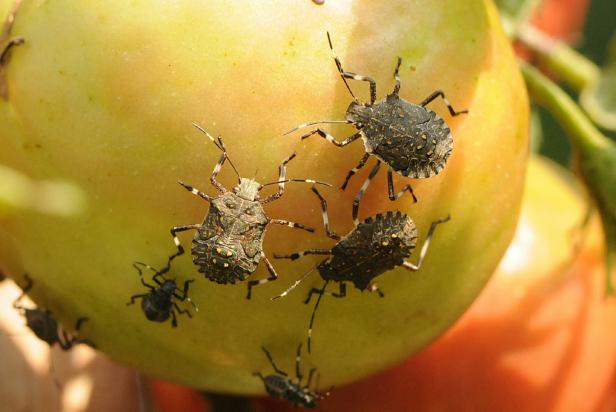How To Get Rid Of Stink Bugs(All You Need To Know)

How To Get Rid Of Stink Bugs: The stink bug is a 6-legged pest with a shield-shaped body and straight antennae. In cold weather, their wings are folded, but in warm weather, they flutter about. They won’t harm your house’s structure, but they will ruin your crops and landscaping. Thankfully, there are several non-chemical ways to trap and kill stink bugs. Do your best to lure them in with water or all-natural insecticides, but remember that crushing a stink bug will release its horrible odor. EnoughInfo.com

To keep pests out for good, it’s a good idea to conduct preventative measures like fixing any cracks and getting rid of any vegetation that could provide them with a hiding place.
Read Also: How To Get Rid Of Cockroaches(All You Need To Know)
FAQs & Answers
1, What keeps stink bugs away?
Examples include thyme, lavender, catnip, and garlic. It is also known that chrysanthemums, marigolds, and radishes deter these pests. And think about growing plants that attract stink bug predators. 2
2, Can you describe the odor of a stink bug?
The stink bug is a member of the family of insects that employs a defensive odor. Stink bugs have a gland in their abdomen that releases a foul-smelling chemical if they are threatened or squished. (Yuck!) Human nostrils detect a fragrance similar to that of cilantro or other herbs and spices combined with a chemical odor. To rephrase: the smell is unpleasant. To get rid of a stink bug without squashing it or making it uncomfortable, you may either take it outside or use an insect-trapping vacuum (or equivalent bug zapper).
3, Do stink bugs bite?
Sticky stink bugs adhere to vegetation and other outside food sources. Stink bugs do not sting or bite, and despite their propensity to startle you by landing on you (or in your clothes or hair), they are usually not dangerous to people.
4, When is stink bug season?
While stink bugs can be seen all year round, you are more likely to spot them in greater numbers in the spring and summer when temperatures rise and the insects that sought refuge from the cold in your home or yard during the winter start to come out into the open again. How To Strengthen Family Bonds(Ultimate Guide)
Removing Stink Bugs
Find the stink bugs by taking a look around
If you just find one stink bug, it can be a sign of a bigger problem. Search your surroundings for warm areas next to heating vents or sunny areas near your walls and windows. Keep an eye out for their brown, gray, or green bodies that can disappear into the background. Look for eggs on the underside of leaves and keep a watch out for discolored leaves if you have an outside infestation.
- Check these plants first since stink bugs love to consume tomatoes, peaches, apples, grapes, berries, maize, soybeans, peppers, alfalfa, and wheat.
- If you smell anything that smells like cilantro in your house but hasn’t squashed any stink bugs, you probably have an infestation.
Kill and remove a stink bug by vacuuming it up
Use a vacuum with a bag to capture the stink bugs. Use a tiny vacuum attachment to gather stink bugs that are hiding in cracks or on walls. To prevent the scent from entering your home, throw away the bag right away. How To Control High-Blood Pressure(The Ultimate Guide)
- As an alternative, you can use a stocking to trap the bugs inside the suction attachment tube before they enter the bag or filter. Push the stocking into the tube after fastening it with a rubber band. Pull out the stocking, knot the end after sucking up the bugs, and throw it away right away.
Plants may be rid of stink bugs by being sprayed with a garden hose
Use a high-pressure jet setting on a garden hose attachment to separate stink bugs from the leaves as soon as you notice them on your plants. When you’ve chased them away, keep an eye on your garden’s plants to see whether the stink bugs return.
- Although the water pressure won’t necessarily kill them out, this is a smart strategy to utilize in case something should happen to your plants.
Setting Traps & Natural Pesticides
Stink bugs may be zapped using an electric insect trap
An electric insect trap may be purchased at a hardware shop and then set up in the area where the stink bugs congregate, following the manufacturer’s instructions. In order to lure the insects at night, you must turn it on. They will receive an electric shock as they approach the bright light of the trap.
- The next morning, when the trap has been turned off, you may either shake the dead bugs off or vacuum them up. How To Strengthen Family Bonds(Ultimate Guide)
Read Also: How To Get Rid Of Cockroaches(All You Need To Know)
The stink bugs can be trapped by placing fly tape at their entryways
Stick fly tape along the window and door frames, as well as any other potential access points, such as cracks and vents. Each day, examine the tape to see whether any insects have become stuck in it. Keep smells to a minimum by replacing the strip after each capture of a single stink bug.
- Although this is not a rapid death, it is possible that stink bugs that have been captured will continue to emit their distinctive stench.
- Every hardware shop will have the fly tape you need.
- A natural sticking trap may be made by heating a solution of water, sugar, and corn syrup in equal parts. Spread it out on some cardboard when it has cooled from the boiling process.
Use a mixture of dish soap, water, and lavender oil to spray any stink bugs you come across
Combine a mild dish soap with 4 cups (950 mL) of boiling water. You may spray this mixture directly on the stink bugs or the plants they’ve been congregating on with a spray bottle. [9] Instead, you might use a mixture of hot water, mild dish soap, and lavender oil to kill the bugs and keep them away.
- Stink bugs are killed by soap because it dissolves their exoskeleton and causes them to dehydrate to death.
To stop stink bugs from reproducing, spray your home with neem oil
Put 2 teaspoons (9.9 mL) of neem oil into 4 cups (950 mL) of warm water and shake well. Make sure it’s well shaken before spraying it liberally on leaves, window sills, and any other potential entryways or hiding locations around your home’s exterior.
- Do this every other day for approximately a week as a prophylactic measure.
- As a natural insecticide, neem oil prevents insects from feeding and mating. As a result, adult stink bugs that come into contact with it will slowly starve to death and stop reproducing.
Utilizing a preventative strategy
Check entry points
Examine all potential entrance sites first, then seal any noticeable cracks or holes. Examine door frames, outside wood siding, window frames (particularly in locations with a lot of sunlight), and even the areas around electrical outlets and lighting fixtures. Caulk any troublesome places (silicone-based caulk is advised for glass) or make any necessary repairs to close off bigger apertures and potential entrance sites.
Close any cracks or openings around your walls, windows, and doors
Check for gaps at the baseboard, doorway, and window frame corners. Examine the weather stripping and linings for damage as well. Any holes you detect should be sealed off with caulk or expanded foam.
- Take steps to block off as many holes as you can since stink bugs will squeeze into every tiny crack or crevice they can discover.
- Check any fireplaces, attics, or other entryways that are rarely used. While not in use, keep doors and fireplace flues closed.
Read Also: What To Do When Your Crush DoesntLove You Back
Install or fix safety screens over windows and air vents
Any holes in your window or door screens should be patched. Cover dryer vents, air vents, chimneys, and other exposed spaces that lead from the outside of your house to the inside by using mesh screening.
- To make a tight seal, use foam strips around your window air conditioners.
Keep weeds out of your property
Under the shelter of weeds, stink bugs like to conceal themselves in dry dirt. No matter how big or tiny your property is, take good care of it. To maintain your grass healthy and weed-free, remove all of the weeds from your land and make an investment in natural lawn care services. Maintain your property’s soil healthy, nutrient-rich, and well-pruned.
- If you want to produce flowers or veggies on your land, think about growing beds around it. You may capture weeds and stink bugs sooner if you spend time outside tending to your plants.
- Mowing over weeds will merely encourage stink bugs to find another place to live nearby, so avoid just doing that. How To Practice Self-Care (All You Need to Know)
Reduce moisture sites
Reducing all moisture accumulation around your house will greatly aid in reducing the likelihood of numerous bug infestations. Look for blocked drains and leaky pipes.
Ventilate
Remove harborage sites, and properly ventilate basements, attics, garages, and crawl spaces. A dehumidifier could be useful in these spaces. Moreover, be sure to cover your attic vents and chimney with screens.
Turn the lights off
Since lights attract stink bugs, it’s advised to use as little outdoor illumination as possible. Close window shades and switch off porch lights in the evening to keep light from coming in from the outside. As yellow bulbs are less appealing to stink bugs, using them for outdoor illumination might be advantageous.
Conclusion
As temperatures drop and people prepare for winter, consider pest-proofing the interior and outside of your home to keep stink bugs and other pests out this autumn. The need to establish winter quarters is signaled by seasonal variations in day duration and temperature for stink bugs. Although these bugs often spend the winter outdoors camped out, they will also look for shelter inside buildings like your house. Stink bugs have only one drawback: they smell bad. They don’t bite, loot the pantry, or eat clothes.
Read Also: How To Control High-Blood Pressure(The Ultimate Guide)




